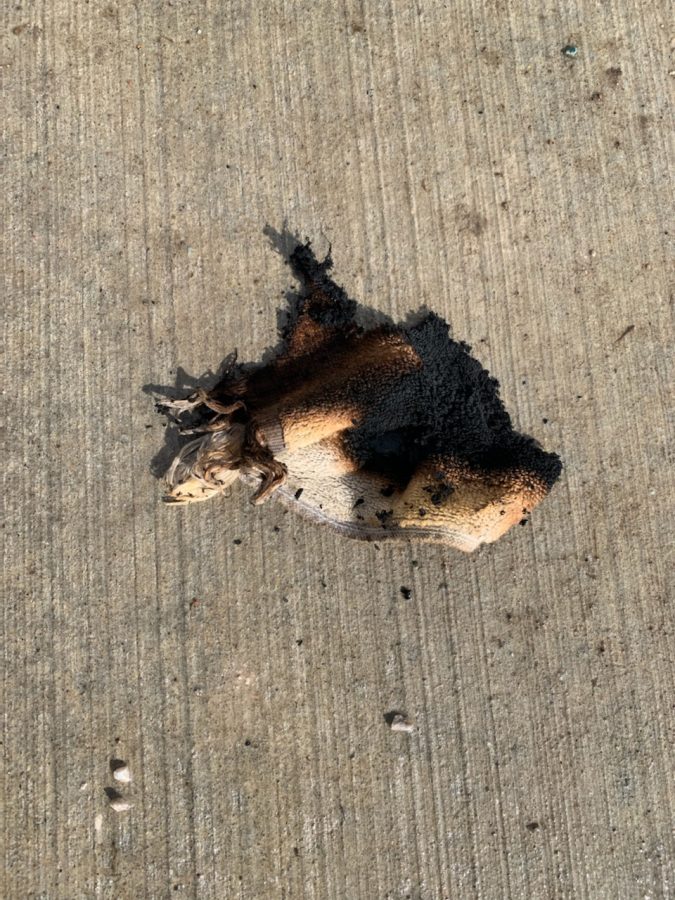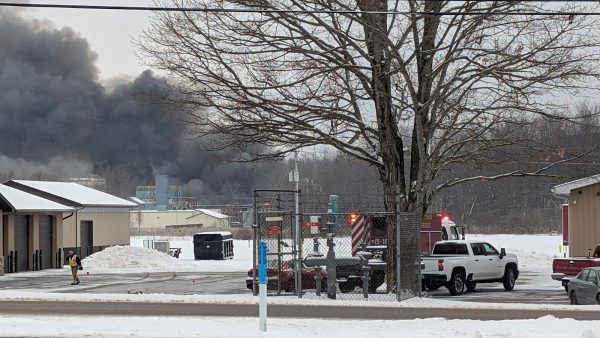Public Safety calls NVII fire an accident, identifies oily rag as cause
On the evening of Saturday, Feb. 5, a fire was reported in a recycling bin in the North Village II dormitory, forcing residents to evacuate for just under an hour as sections of the building filled with smoke. Responders from the Meadville Central Fire Department cleared the smoke from the building with fans and by opening windows. The cause of the fire has been identified as an oily rag that likely spontaneously combusted in the recycling bin, causing a lot of smoke but little to no flames.
The incident was first reported by a student who noticed the smoke, pulled the fire alarm, and dragged the still-smoking bin to the entry bridge on the southeast side of the building. Shyler Kreitz, ’22, was one of the first students out of the building after the alarm was pulled. He said that the student who grabbed the bin just saw it and decided to act.
“She was explaining that she was leaving to head to her apartment, and she saw the trash can, and she was like, ‘yeah, I’m going to do something about this,'” said Kreitz.
Director of Counseling Trae Yeckley was on call at the time of the incident. They have identified the student that pulled the bin out but declined to disclose the student’s identity out of respect for their privacy.
“We’re incredibly grateful that she did that,” Yeckley said. “(The students) were incredibly responsive and incredibly helpful. I’m really proud of our students, and I’m glad that we were able to get them back in their space as soon as we could.”
According to the Office of Public Safety’s Crime and Fire Log, the incident was first reported at 5:27 p.m. At 5:33 p.m., the Meadville Central Fire Department was alerted, according to MCFD Chief Patrick Wiley. At around 5:37 p.m., responders were on the scene. By 6:20 p.m., the alarm had been shut off and students were seen returning to the building.
At 6:31 p.m., after students were back in NVII, came the first communication to the entire campus community through the “ALERTAllegheny” service. According to Director of Public Safety James Basinger, the message was sent not to notify the community of the emergency but to combat misinformation that had been rapidly spreading online.
“It was debatable if we even needed to send that but we sent it because of the misinformation,” Basinger said. “Talking with Dr. Yeckley, they had informed me that there was a lot of information out on different social media sites that was inaccurate, and in the interest of the mental health and wellbeing of our students, we thought we’d better put out a message to let them know the gravity of the fire, that it was a very small trashcan fire, there was no structural damage, and that we would be letting students back in relatively soon.”
Had the situation been more dire, the message would have been sent out with greater urgency.
“With a weather emergency or storm coming, it’s a current and ongoing threat. Or, if there’s an active shooter — that would be a message that would go out, without question, within minutes or seconds of it being reported,” Basinger said. “This was basically an enhanced smoke alarm because we had to ventilate the building. It wasn’t even really a fire, because it just smoldered and made a lot of smoke.”
The MCFD agreed with this sentiment, as much of the hour was spent clearing smoke from the four-story building, which contains just under 90 student suites.
“The incident was more of a hazard (because) of the smoke,” Wiley said. “That building takes a while to clear out.”
Another reason the building took time to clear was that opening the windows to accommodate fans took time.
“It would’ve been quicker, but we had to remove the safety stops on the windows so the exhaust fans would fit in to ventilate the building,” Basinger said.
Ordinarily, the safety stops keep the windows from opening to their fullest extent, to prevent accidental or intentional autodefenestration.
Wiley said that the fire was likely just an accident.
“It was unintentional, most likely caused by some paper or a rag with some grease,” Wiley said.
According to the National Fire Prevention Association, oily or greasy rags are prone to spontaneous combustion because as they dry, they release heat. If the rag is piled or bunched, then the heat is trapped and can build until the rags catch fire. To prevent this, the NFPA recommends leaving rags outside to dry. The rags should be stretched out away from buildings to minimize risk. Alternatively, the rags can be sealed in a metal container with a mixture of water and cleaning detergent to break down the oils in the rags.
Since the Saturday incident, rumors have spread amongst the student body regarding the true cause of the fire, mainly that a student had been smoking marijuana and threw a still-hot joint into the trash can, starting the blaze.
Basinger said that the marijuana hypothesis was not backed up by Public Safety’s investigation
“We’ve interviewed the student who carried the garbage can out and some other students that were there shortly after the garbage can was carried out, and by all accounts it’s just an accident,” Basinger said. “I know there were rumors on campus that there may have been other causes. There’s no indication of the physical evidence that that information is accurate.”
Specifically, Basinger noted that the distinctive smell of the drug was not present on the bin. He also said that Public Safety is not actively searching for the person who may have placed the rag in the bin, and that the office is waiting for a full report from the MCFD to close the investigation.
Public Safety would like to remind students to adhere to the following Fire Safety rules in The Compass, Allegheny College’s student handbook.
Open flames are not permitted, including candles and incense. Tapestries cannot be hung from the ceiling or in front of the door. Halogen lamps and smoking are forbidden, as is covering or tampering with smoke detectors. Electronics are also fire hazards; extension cords are required to be 14-gauge wire and surge protectors must be heavy duty and utilize a self-tripping breaker.
Public Safety also shared some fire safety tips and suggestions, including keeping hot items out of the trash, and fire extinguishers easy to access. Combustible material should be kept away from stove tops and ovens. To prepare for an emergency, familiarize yourself with fire pull station locations, fire extinguisher locations, and evacuation routes. And should you see a grease fire, extinguish the fire by smothering it with a metal lid or by using a class-K or class-B fire extinguisher.

Sami Mirza is a senior from many different places. He is majoring in International Studies with a focus on the Middle East and North Africa and minor in...










